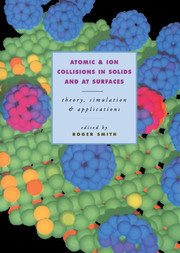6 - The rest distribution of primary ions in amorphous targets
Published online by Cambridge University Press: 13 October 2009
Summary
Introduction
In many applications it is the rest distribution of the implanted (or primary) ions that is of principal importance, e.g. in the doping of semi-conductors (Sze, 1988). We examine this in detail because of its intrinsic importance and also because we can illustrate some modern statistical and numerical techniques applied to transport theory in a little more detail than described in the previous chapter. The penetration of ions into amorphous targets is described most simply by using a statistical transport model. The use of this model has the advantage that two methods exist for the prediction of the rest distribution of ions: the solution of transport equations (TEs) and Monte Carlo (MC) simulation. A statistical model is essential to the construction of TEs and the computational efficiency that it affords MC simulation is necessary in order to obtain good statistics.
In several ways the MC and TE methods are complementary. In direct form the MC method treats an explicit sequence of collisions, so the target composition can change on arbitrary boundaries (in space and time). The rest distribution is built up from a large number of ion trajectories, the statistical precision of which depends directly on this number. Hence, the use of the MC method is dependent on the necessary statistical precision being obtained in a ‘sensible’ amount of CPU time. On the other hand, Lindhard-type TEs assume a target that satisfies space (and time) translational invariance. The only target to satisfy this condition is infinite and homogeneous.
- Type
- Chapter
- Information
- Atomic and Ion Collisions in Solids and at SurfacesTheory, Simulation and Applications, pp. 161 - 202Publisher: Cambridge University PressPrint publication year: 1997

